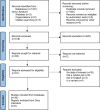Implementing Robotic Pets in Continuing Care Settings: A Scoping Review of Barriers and Facilitators
- PMID: 40331596
- PMCID: PMC12554848
- DOI: 10.1111/jgs.19510
Implementing Robotic Pets in Continuing Care Settings: A Scoping Review of Barriers and Facilitators
Abstract
Background: Robotic pets are a unique technological innovation found among facility-based continuing care (CC) settings for older adults living with or without dementia. While researchers have reported positive outcomes for older adults who interact with robotic pets, unintended negative consequences may occur if robotic pets are not implemented properly. We examine the current evidence describing barriers and facilitators of implementing robotic pets for older adults residing in CC facilities to inform implementation practices.
Methods: A scoping review was conducted following the methodological framework outlined by Arksey and O'Malley. Five databases and the CADTH Gray Matters tool were used to identify relevant articles and gray literature. Our inclusion criteria followed the Population, Concept, Context (PCC) framework: Population: older adults living with or without dementia; Concept: barriers and facilitators to implementing robotic pets to older adults; Context: CC facilities. Two reviewers independently screened all titles, abstracts, and full-text articles and extracted the data. Two reviewers also organized barriers and facilitators into the theoretical domains framework (TDF) domains, which map onto the capability, opportunity, and motivation behavioral Change Wheel (COM-B).
Results: We identified 518 unique articles from our database and gray literature search, 42 of which met our inclusion criteria. Barriers and facilitators were identified across all 14 domains of the TDF and all six components of the COM-B. Domains mentioned in ≥ 50% of the articles include environmental context and resources, beliefs about consequences, and social influences. Common facilitators include knowledge of the benefits of robotic pets and how to use robotic pets, while common barriers include concerns over infantilization and hygiene.
Conclusions: Our findings will help inform care providers of the barriers and facilitators to implementing robotic pets within CC settings with the goal of improving the quality of life of older adults.
Keywords: caregivers; dementia; residential continuing care; robotic pets; therapeutic intervention.
© 2025 The Author(s). Journal of the American Geriatrics Society published by Wiley Periodicals LLC on behalf of The American Geriatrics Society.
Conflict of interest statement
The authors declare no conflicts of interest.
Figures



References
-
- Enders‐Slegers M. J. and Hediger K., “Pet Ownership and Human–Animal Interaction in an Aging Population: Rewards and Challenges,” Anthrozoös 32, no. 2 (2019): 255–265, 10.1080/08927936.2019.1569907. - DOI
Publication types
MeSH terms
Grants and funding
LinkOut - more resources
Full Text Sources
Medical
Miscellaneous

